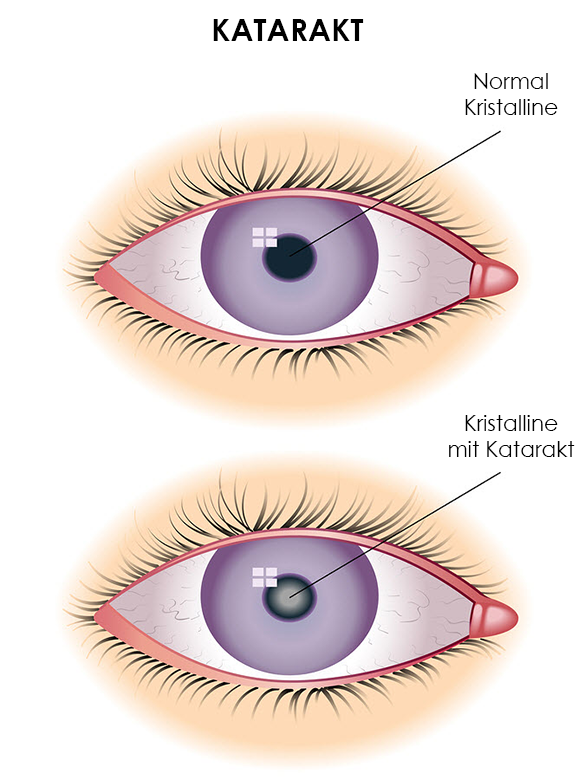Globally, 240 million people experience visual impairments caused by cataracts that affect their daily lives. Fortunately, cataracts can typically be removed safely and effectively and vision can be restored. In fact, cataract removal is one of the most common surgeries in the world. When a cataract is removed, an intraocular lens (IOL) is often implanted. But what exactly is an IOL?
Why do I need an intraocular lens?
To understand IOLs, it’s best to start with why you need one in the first place. Cataract surgery involves removing the eye’s natural lens. The lens plays an important role in vision. When light enters the eye, the lens refracts (bends) the light rays to create an image in your eye, allowing you to see. The lens should be clear, but if a cataract is present, the lens becomes cloudy and a cloudy lens can cause things to look blurry, hazy or less colorful. When the natural lens is removed, it is commonly replaced with an artificial lens called an intraocular lens or IOL for short.
How long have IOLs been used?
IOLs have been a part of modern ophthalmology for over three decades. In fact, since the early 1980s, surgeons have been using IOLs to replace the eye’s natural lens during cataract surgery. Of course, over time, IOLs have (and continue to) advance technologically. Today, there are many different IOLs to choose from. Which type a patient chooses depends on factors that include lifestyle, specific visual needs and surgeon recommendations.
What is an IOL made of?
Early IOLs were made of rigid materials like polymethylmethacrylate (PMMA). But today’s IOLs are more commonly made of flexible materials like silicone or acrylic. They also contain special materials to help protect the eyes from the sun’s harmful ultraviolet rays.
What are the different types of IOLs?
There are different types of IOLs available: Traditional IOL (also known as Monofocal), Multi-focal, Accommodative, Toric, and Extended Depth of Focus.
- A Traditional IOL or Monofocal IOL is the most common type of lens used with cataract surgery. It offers clear vision at one distance only – it is designed for either close range, medium range or distance vision. Most people have their Monofocal IOLs set for far vision and then use reading glasses for close up vision. The main advantage of a traditional IOL is that it is the least expensive and is usually covered by health insurance. But with this choice, most people will still need to wear glasses, at least some of the time.
- Multifocal and Accomodating IOLs offer clear vision for both close up and distance vision at the same time. These lenses are known as premium lenses because their goal is to reduce or completely eliminate the need for glasses or contact lenses. The advantage of multifocal IOLs is that they offer the best chance to be glasses-free, which is appealing to active adults who find glasses frustrating. However, multifocal IOLs also can create difficulties with night vision such as glare and/or halos around light. But, because Medicare considers them to be a premium option, the expense is not usually fully covered and the patient must pay a premium. (An Accomodating IOL functions similarly to a multifocal IOL except that it moves or changes shape inside the eye.)
- Toric IOLs are designed for people with astigmatism. Toric IOLs can correct the refractive error caused by a cornea with an irregular shape. The main advantage of a Toric IOL is that it usually offers patients uncorrected distance vision that is even clearer than they experienced before developing cataracts. But like Monofocal IOLs, they are designed to correct only one distance so most people will still need to rely on reading glasses or contact lenses for near and intermediate range vision.
- Extended Depth of Focus (EDOF) IOL is a new technology that has recently emerged to provide a full range of vision from near through far. Unlike a multifocal IOL, which provide clear vision at separate discreet points, EDOF lenses improves the range of vision without splitting the light rays. The goal of an EDOF is clear vision across all distances.
How do I know which IOL to choose?
There are many factors to consider when choosing an IOL such as lifestyle, price, function and long-term satisfaction. A cataract surgeon will be able to discuss the advantages and disadvantages of different types of IOLs and help you choose the type that best suits your needs and preferences.
References:
http://www.allaboutvision.com/conditions/iols.htm
https://www.aao.org/eye-health/diseases/cataracts-iol-implants
http://yoursightmatters.com/different-types-iols/
http://www.webmd.com/eye-health/tc/intraocular-lens-implant-iol-for-cataracts-topic-overview#1
https://crstoday.com/articles/2011-sep/focus-on-iol-material-does-iol-material-really-matter/
http://ophthalmologytimes.modernmedicine.com/ophthalmologytimes/news/are-extended-depth-focus-iols-hitting-visual-sweet-spot?page=0,1
MarketScope 2016 IOL Report



